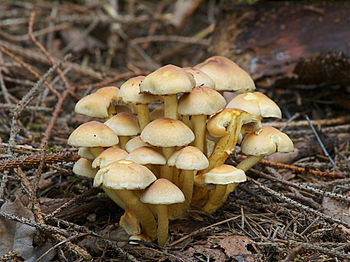Talk:Hypholoma fasciculare
| This article is rated Start-class on Wikipedia's content assessment scale. It is of interest to the following WikiProjects: | |||||||||||
| |||||||||||
After I made 'Hypholoma fasciculare' on 10th Nov. 2005 I discovered that 72.192.1.41 had made one called 'Sulfur Tuft' on 9th No. 2005. The text is as follows.
Sulfur Tuft Naematoloma fasciculare
Also known as the Clustered Woodlover, this common poisonous mushroom is usually found in clumps on both conifers and hardwoods: stumps, rotting logs, and buried debris. The bald caps are yellow, often slightly greenish or orangeish, darker at the center, the stalk is slender, the gills are yellow to greenish-yellow, becoming grey or purple with age. Spores are deep purple.
similar species:
Hypholoma fasciculare Naematoloma capnoides
I have incorporated some details from this page in 'Hypholoma fasciculare' and will replace the 'Sulfur Tuft' page with a link to 'Hypholoma fasciculare'.
Strobilomyces 18:57, 13 November 2005 (UTC)
File:Hypholoma fasciculare LC0091.jpg to appear as POTD soon
[edit]Hello! This is a note to let the editors of this article know that File:Hypholoma fasciculare LC0091.jpg will be appearing as picture of the day on November 30, 2011. You can view and edit the POTD blurb at Template:POTD/2011-11-30. If this article needs any attention or maintenance, it would be preferable if that could be done before its appearance on the Main Page so Wikipedia doesn't look bad. :) Thanks! howcheng {chat} 18:53, 28 November 2011 (UTC)
Lower lignin content?
[edit]The article avers that deciduous wood has "lower lignin content" than coniferous wood. Can this be possible? Oils and resins might be what make coniferous wood less to the fungus' requirements. --Wetman (talk) 17:59, 30 November 2011 (UTC)
External links modified
[edit]Hello fellow Wikipedians,
I have just modified one external link on Hypholoma fasciculare. Please take a moment to review my edit. If you have any questions, or need the bot to ignore the links, or the page altogether, please visit this simple FaQ for additional information. I made the following changes:
- Added archive https://web.archive.org/web/20050505044124/http://journals.tubitak.gov.tr/botany/issues/bot-04-28-1-2/bot-28-1-2-23-0207-2.pdf to http://journals.tubitak.gov.tr/botany/issues/bot-04-28-1-2/bot-28-1-2-23-0207-2.pdf
When you have finished reviewing my changes, you may follow the instructions on the template below to fix any issues with the URLs.
This message was posted before February 2018. After February 2018, "External links modified" talk page sections are no longer generated or monitored by InternetArchiveBot. No special action is required regarding these talk page notices, other than regular verification using the archive tool instructions below. Editors have permission to delete these "External links modified" talk page sections if they want to de-clutter talk pages, but see the RfC before doing mass systematic removals. This message is updated dynamically through the template {{source check}} (last update: 5 June 2024).
- If you have discovered URLs which were erroneously considered dead by the bot, you can report them with this tool.
- If you found an error with any archives or the URLs themselves, you can fix them with this tool.
Cheers.—InternetArchiveBot (Report bug) 10:01, 7 April 2017 (UTC)


